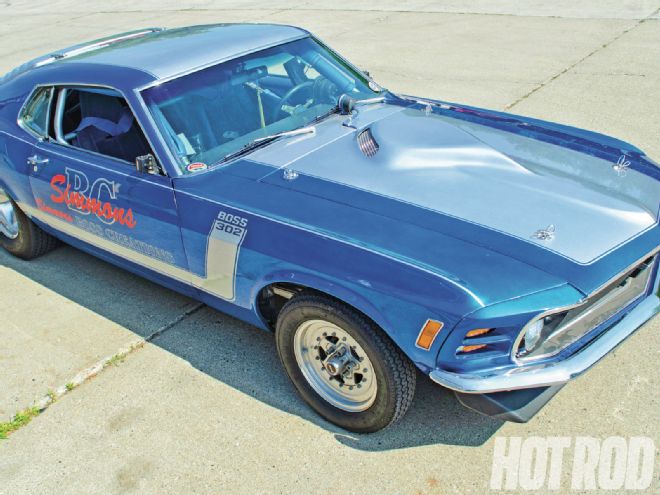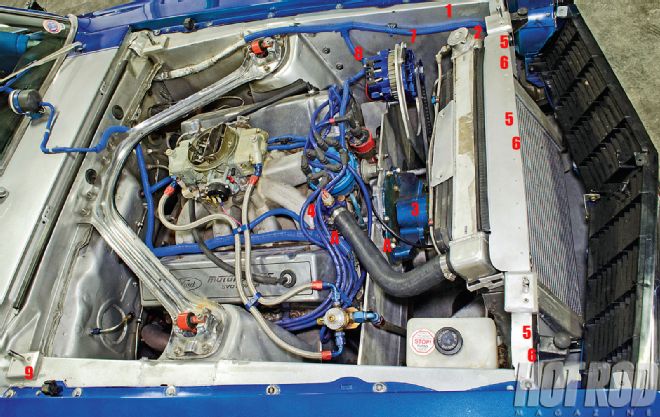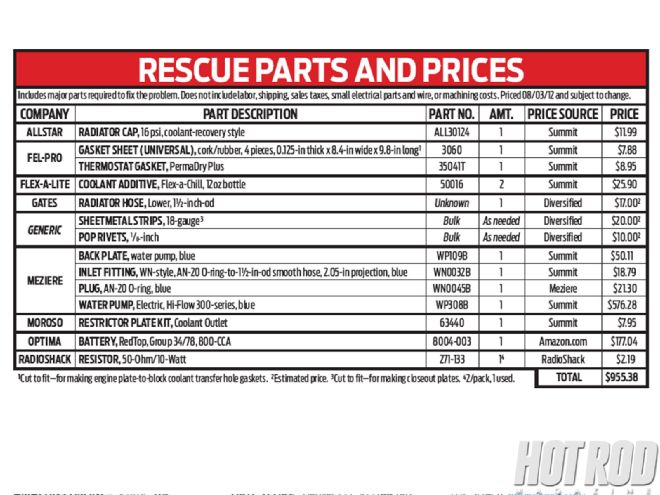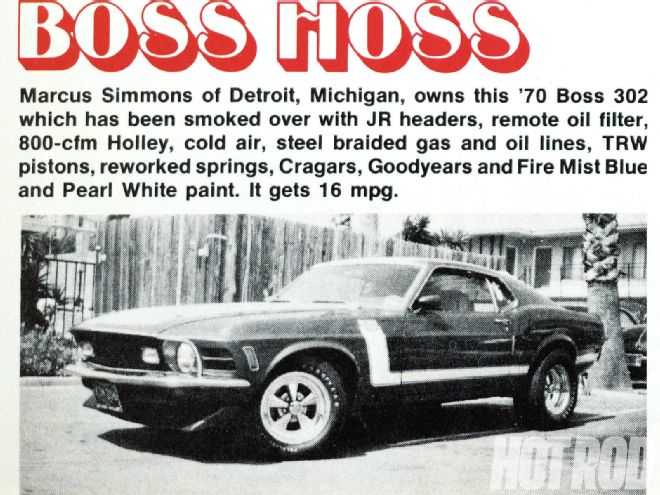
The Combo
Engineer Marcus Simmons has been involved with hot rods, the Detroit automotive industry, and racing his entire adult life. He’s owned his ’70 Mustang Boss 302 almost as long, ordering it brand-new from the dealer back in 1970. Since then, the car has gone from a street cruiser (having done a cross-country jaunt to California back in 1972 and several 140-mph-plus Banzai runs down the freeway), to a full-on, pure drag racer, to its present incarnation as a Pro Street car and occasional weekend dragstrip warrior. Currently, the car runs a 560hp 460 Ford big-block crate motor, C6 automatic trans, and 4.57:1-geared 9-inch Ford rearend with a Detroit Locker diff and 31-spline axles.
The Problem
Even under the best of conditions, transforming a gutted race car back into a streetable vehicle is a lot of work. In Marcus’ case, it was made even tougher, as he is now legally blind. The diagnostics and troubleshooting Marcus was once able to perform himself at his fabrication shop, Boss Creations, must now occasionally be farmed out to third parties. When he contacted HOT ROD, Marcus’ main complaint was "the vehicle will not turn over when hot. I am using 00-gauge battery cables from the 800-CCA Motorcraft battery and a dedicated 0-gauge negative return cable back to the battery. When that didn’t help, I added a layer of starter wrap to the starter. No change, even after adding yet another layer."
Further conversation revealed that "running hot" meant as high as 240 degrees F in traffic--this despite a big aluminum crossflow radiator; a shroud-mounted 3,300-cfm Flex-a-lite electric fan; a Meziere electric water pump; and Evans waterless coolant. When a car gets that hot, all sorts of things can go wrong, and not just with the starter. If the coolant temperature was 240 degrees F, the oil temperature could be approaching 300 degrees F, putting the engine in serious danger of meltdown.
On the electrical side, Marcus seemingly should have had it covered with the big battery, the fat cables, and a typically highly efficient, 100-amp GM 12SI alternator. Still, when things get that hot, you could be looking at a case of excessive voltage drop compounded by heat soak.
So was the problem caused by the cooling system, the electrical system, or both? To find out, we sent the car to Diversified Creations, a high-end Detroit-area shop that does everything from dyno-tuning to complete, ground-up car fabrication. Regular readers may recall Diversified as the builders of the HOT ROD E-Rod Z28 Camaro.
The Fix: Cooling
Reasoning that it was impossible to diagnose the starting problem until the overheating issues were addressed, Diversified first checked each cooling-system component. The big 460 had been dropped in the former drag-race car using a front engine plate in lieu of normal side mounts. This led to clearance issues with stock-style accessory drives. Simmons had to mount the large aluminum radiator at about a 15-degree back rake for engine-plate, water-pump, electric-fan, and alternator clearance (the radiator bottom bolts in front of the core support and the top is behind the core support). The odd radiator installation; the engine bay–spanning, bulky engine plate; the old Mustang chassis’ intrusive high-mount shock towers; and tight-fitting, heat-radiating, big-tube exhaust headers collectively made for poor engine-compartment air circulation. As Diversified’s head honcho, Mike Copeland, put it, "There’s just no place for heat to go, so it heat-soaks everything." Diversified found that at least the thermostat was opening, the electric fan was getting juice and moving air, and significant radiator inlet and outlet temperature differentials indicated the radiator was in fact cooling.
On the downside, the radiator cap wouldn't maintain system pressure. Diversified replaced the bad cap with a new 16-psi one, which should have improved the cooling system's efficiency. But at this point, the now-higher system pressure resulted in leakage out of the thermostat-housing gasket as well as from the silicone beads sealing the water pump to the front-engine mounting plate and the mounting plate to the engine. Replacing the leaking thermo-housing gasket was a cinch; fixing the leaks in the engine plate took some effort. Diversified TIG-welded shut the plate's ragged and misaligned coolant-transfer holes, then accurately drilled new, properly aligned holes. Stock 460 Ford water-pump gaskets were then installed on the plates' water-pump side, and custom gaskets fabricated from universal sheet-gasket material were made for the engine side.
As received, the car had a drag racing--style Meziere electric pump that flowed just 35 gpm (gallons/minute)--not enough for street use. This was replaced by a gonzo 55-gpm Meziere electric pump. It has no internal bypass, so to prevent cavitation, Diversified replaced the stock thermostat with a Moroso restrictor plate. The pump needed larger inlet fittings, plus a new, larger, 1-1/2-inch-od radiator hose. Lead Tech Scott Rouston isn't exactly sure what stock application the new molded hose he used is from, other than it's a Gates product; he went down to the local auto parts store and pulled one that "looked right" off its ceiling hanger. It required only slight trimming for proper fitment.
Sheetmetal closeout plates were also fabbed up to direct grille airflow through the radiator core (rather than letting it escape around its periphery). The cooling fixes brought overall engine gauge temps down to a satisfactory 180 degrees F, solving the engine overheating problem. Still, even with the hood off, engine-bay temps remained higher than optimal: 105 degrees F in front of the core support, 130 degrees at the front of the motor plate--but 210 degrees at the firewall. Short of re-engineering the entire engine installation, this was as good as it was gonna get.

116-PSI Radiator Cap 2 Flex-a-Chill Additive 3 Meziere 55-GPM Electric Water Pump A Fix Coolant Leaks 4 Moroso Restrictor Plate 5,6 Closeout Plates 7 Diagnos Electric Charging problem 8 Rewire Alternator 9 Trunk-Mounted Optima Battery
The Fix: Electrical
With engine temps now stable, Diversified turned to the electrical system. Voltage checks revealed both battery and alternator problems. Proper charging wasn't an issue when the car was still a full-on race car; it was normal for the team to put the car on a charger at the shop and then spend the day at the racetrack. But now, cruising on the street, the car had cranking problems after it got hot under sustained operation, and there was no handy access to the external charger.
At first, it seemed the battery was just ancient and worn out, but the warranty tag showed it to be relatively new. It had prematurely aged both functionally and appearance-wise because the charging system wasn't up to snuff. Under operating conditions, the battery was constantly discharging. As a first step, Diversified replaced the tired battery with an Optima RedTop Absorbed Glass-Mat dry-cell battery, then ran more voltage tests.
It turned out the exciter wire that normally runs from an ignition terminal to the GM 12SI alternator's No. 1 terminal wasn't properly installed. Without a functional exciter wire, the alternator wouldn't charge until engine speed climbed past 2,000 rpm. At that point the alternator finally self-excited, yet when rpm dropped back to idle it still put out just 12.6 volts. This was insufficient with all the car's electrical accessories, which was why the battery was losing charge under normal low-speed street-driving conditions. Diversified correctly rerouted the exciter wire and added an inline resistor to mimic a stock GM dash-mounted idiot light bulb. The alternator needs resistance in the exciter-wire circuit to ensure proper turn-on and turn-off functionality.
There was also some concern about the alternator's underdrive pulley (another race-car trick that really has no place on a street-driven car). Diversified looked at replacing the pulley, but clearance issues would require re-engineering the entire front drive and mounting system. In any case, in this instance, the exciter-wire fix proved sufficient to allow the 100-amp alternator to maintain proper low-speed charging capability.
Results
After resolving the overheating and charging issues, the starter now cranks fine under all conditions. The engine temp stays at 180 degrees F, the alternator maintains 14.7 volts, and the starter receives no less than 12.8 volts. Now Simmons, riding shotgun, can once again partake in Detroit's hot summer cruise nights with no problems.
Lessons Learned
Any doctor will tell you: Don't treat the symptoms--diagnose the cause to find the cure. Cough medicine may suppress the cough, but why are you coughing? Likewise, the cranking problem was only a manifestation of too-high engine temps, plus a charging problem. Voltage and temperature tests will show where the real problems lie.
Voltage Test Results
Before Fix
After Fix
Check Point and Condition
Cold
Hot
Cold
Hot
Battery, engine off
12.9
12.6
—
—
Alternator, engine off
12.9
12.6
—
—
Starter primary cable, engine crank
10.5
9.9
12.8
12.8
Alternator, engine on, sustained idling
—
13.0
—
14.7
Alternator, engine on, over 2,000 rpm
—
14.4
—
—
Battery, engine on, sustained idling
—
12.6
—
14.2
Battery, engine on, over 2,000 rpm
—
13.9
—
—
Note: All values are in volts.
 10 Way back in 1972, when it was still a street muscle car, Simmons drove the '70 Boss 302 Mustang all the way out from Detroit to California, where he visited HOT ROD's old Hollywood offices. Here is the photo as it appeared in our very first Readers' Rides section. "I was just breaking in a new engine," Simmons says.
">
10 Way back in 1972, when it was still a street muscle car, Simmons drove the '70 Boss 302 Mustang all the way out from Detroit to California, where he visited HOT ROD's old Hollywood offices. Here is the photo as it appeared in our very first Readers' Rides section. "I was just breaking in a new engine," Simmons says.
">
 <STRONG>10</STRONG> Way back in 1972, when it was still a street muscle car, Simmons drove the '70 Boss 302 Mustang all the way out from Detroit to California, where he visited HOT ROD's old Hollywood offices. Here is the photo as it appeared in our very first Readers' Rides section. "I was just breaking in a new engine," Simmons says.
<STRONG>10</STRONG> Way back in 1972, when it was still a street muscle car, Simmons drove the '70 Boss 302 Mustang all the way out from Detroit to California, where he visited HOT ROD's old Hollywood offices. Here is the photo as it appeared in our very first Readers' Rides section. "I was just breaking in a new engine," Simmons says.